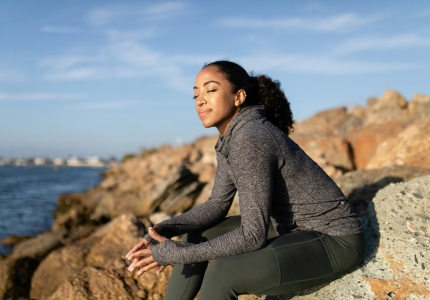Not all stress manifests the same way. Some feel it in their bodies, tight shoulders, fatigue, headaches. Others experience it as racing thoughts or emotional overwhelm. Because each form of stress expresses itself differently, not all types of relaxation will be equally effective.
Understanding your personal stress symptoms is the first step toward choosing how to relax effectively. This guide invites you to listen to your body and mind, to recognize the language of tension, and to find the type of relaxation that truly restores balance.
Learn to Identify the Most Common Stress Symptoms
Stress often sends signals long before we consciously notice it. These stress warning signs can appear in physical, mental, or emotional form, each requiring a different kind of care.
Physical symptoms
Muscle tension, jaw clenching, headaches, fatigue, or shallow breathing. These indicate the body is overworking and needs release through movement or rest.
Mental symptoms
Rapid thoughts, difficulty concentrating, forgetfulness, or insomnia. When the mind is overstimulated, it craves focus and gentle direction rather than silence alone.
Emotional symptoms
Irritability, sadness, anxiety, or sudden mood swings. These are signs that your emotional world needs comfort, soothing environments, and grounding rituals.
Recognizing these patterns creates a bridge between stress and body connection, helping you respond with awareness instead of reaction.
Relaxation Techniques for Each Type of Stress
Every body speaks differently, so each needs a unique response. The following relaxation techniques by symptom are simple yet deeply effective ways to restore calm.
For physical stress:
Try gentle stretching, a warm bath, or a slow self-massage. Focus on releasing tension from key areas such as neck, shoulders, and back. Heat therapy or soaking in water helps the muscles relax and enhances blood circulation.
For mental stress:
Practice guided meditation, journaling, or mindful breathing. These help declutter the mind and channel energy into focus. When thoughts feel scattered, listening to a calm voice or visualizing peaceful imagery can reestablish clarity.
For emotional stress:
Try deep breathing, aromatherapy, or reconnecting with nature. A walk surrounded by trees or near water resets the nervous system and creates emotional spaciousness. Scents such as lavender and orange also support emotional stress relief.
There is no single formula for relaxation; the most effective method is the one that feels natural to you, the one your body and mind instinctively respond to with ease and comfort.
The Power of Water, Silence, and Conscious Breathing
Some elements are universally calming, gently guiding both mind and body toward stillness, no matter how stress chooses to manifest. They act as anchors of serenity, simple, timeless forces that invite release, balance, and quiet renewal.
Water for relaxation
Thermal baths, mindful showers, or even a cold plunge in a Frigidarium activate circulation and balance the nervous system. Water invites both surrender and renewal.
The power of silence
Taking digital breaks, embracing quiet spaces, or simply pausing between activities can significantly reduce sensory overload. Silence acts as a soft reset for the mind.
Conscious breathing for stress relief
Techniques such as the 4-7-8 breath or abdominal breathing slow the heartbeat and activate calm responses within minutes.
Together, these rituals create a sensory rhythm that soothes the nervous system and invites presence.
Design Your Own Ritual to Restore Calm
Once you understand your stress symptoms, you can create a personal stress relief routine that truly serves you. The goal is not perfection but presence.
Combine different techniques intuitively: a warm bath followed by guided meditation; a quiet walk with conscious breathing; or aromatherapy before sleep paired with gentle stretching. Over time, these actions evolve into restorative habits that anchor your days in calm.
Learning how to relax effectively starts with awareness. By recognizing your stress symptoms, physical, mental, or emotional, you can choose the type of relaxation that truly supports you. Each small act of self-care, from conscious breathing to time spent in silence, helps restore balance and calm the nervous system.
Relaxation is not an escape, but a return to balance. When practiced with intention, it becomes a ritual that nurtures both body and mind, helping you meet daily life with greater clarity and ease.



